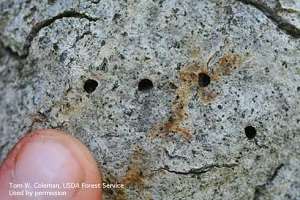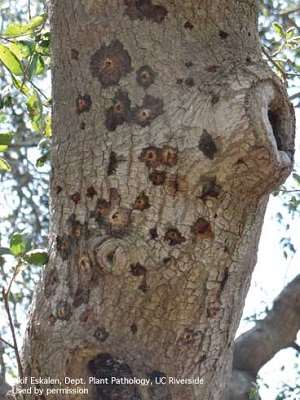By Mary Louise Flint
Over the last several decades, dozens of exotic pests have invaded California landscapes, causing at least temporary havoc and sometimes severely affecting the aesthetic value of plants or even killing them.

Three bark beetles of concern to landscapers and gardeners are described in the following paragraphs. For information on these and other exotic pests see the web sites of the UC Riverside Center for Invasive Species Research, the California Department of Food and Agriculture, or the UC Statewide IPM Program.
Goldspotted Oak Borer
First identified in eastern San Diego County in 2004, the goldspotted oak borer, Agrilus auroguttatus, has killed over 25,000 California native red oaks since its arrival and has now been detected in Riverside County. Larvae feed deep within the phloem, and adults are rarely seen. Infestations are recognized by the presence of D-shaped exit holes on trees, often accompanied by bark staining and crown decline. There are currently no good ways to manage the pest in moderate to severely infested trees. Contact your agricultural commissioner if you find infestations outside the known infested area. More information is available at http://www.ipm.ucanr.edu/PMG/PESTNOTES/pn74163.html.
Walnut Twig Beetle and Thousand Cankers Disease

Walnut twig beetle, Pityophthorus juglandis, is a tiny bark beetle that attacks only walnut trees. The beetle has been in California for many decades but recently became associated with a new fungus, Geosmithia morbida. The fungus kills the phloem and cambium of the tree but cannot move far within the tree on its own; it is dependent on the beetle to spread it as the beetle bores into trees to feed and reproduce. The disease caused by this beetle-fungus-complex is called thousand cankers disease because it leaves hundreds of lesions on severely infested trees. The disease can kill trees within several years and many black walnuts along roadsides and riparian areas throughout California have died. No effective management tools are available. More information is available at http://www.ipm.ucanr.edu/PMG/menu.thousandcankers.html.
Polyphagous Shot Hole Borer
Like the walnut twig beetle, this tiny borer, Euwallacea sp., spreads a fungal pathogen (in this case a Fusarium species) as it bores into trees. The relationship between the beetle and fungus is a symbiotic one with the beetle feeding on the fungus as it grows through the vascular system of trees. This beetle and pathogen have a broad host range and many trees have been affected including avocados, boxelder, coast live oak, liquidambar, and sycamore. Initial finds were in the Los Angeles area in 2012, but the beetle and disease have now been found as far north as Santa Cruz.
Source: ucanr.edu